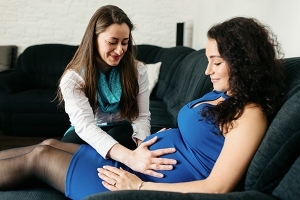
Exercise during and after pregnancy
Pregnancy is a time of intense awareness of the body as physical change unfolds rapidly. It’s a time to observe the awe-inspiring power of the body while enduring a range of new and surprising discomforts. According to Elizabeth Hepp, owner and instructor at Sweat Like a Mother (S.L.A.M.) San Diego, regular exercise can either improve or prevent many of the common complaints associated with the prenatal and postnatal periods.
Benefits of Prenatal Exercise
“Regular exercise can reduce overall pregnancy-related aches and pains like back pain, swelling, constipation and poor sleep,” says Hepp. In addition, a consistent fitness routine has been shown to prevent more serious complications like gestational diabetes, preeclampsia, excessive maternal weight gain and cesarean section. Perhaps most importantly, exercise can improve mental health—a serious concern during this period of major physical and emotional change.
Benefits of Postpartum Exercise
According to Hepp, weight and resistance training is incredibly important for all women of childbearing age. Making time for these activities now can prevent common problems in the postmenopausal years—such as osteoporosis and cardiovascular disease. Postpartum exercise also does wonders for mood, confidence and self-esteem in new mothers. “While it is important to truly rest for a period after having a baby, returning to movement gradually can have huge benefits for mothers,” she says. “It often allows them to feel like themselves again in both a performance and aesthetic sense.”
Pelvic Floor Health
It is normal for pelvic floor muscles to become stretched and weakened during pregnancy and birth. Injuries in this area can lead to incontinence or sexual dysfunction—and sometimes symptoms emerge years after giving birth. Hepp encourages all postpartum women to make an appointment with a pelvic floor physical therapist, which is also now recommended by The American College of Obstetricians and Gynecologists six weeks after giving birth.
“Birthing a baby is a major physiological event, and pelvic floor physical therapists are the experts with the knowledge to diagnose and treat any issues that arise,” Hepp says. Once a woman knows the status of her pelvic floor health, a qualified postpartum trainer can work in cooperation with a PT to create a modified fitness routine that will help her achieve her goals.
Setting Healthy Postpartum Fitness Goals
Hepp encourages new moms to set healthy expectations for the time it will take to reach fitness goals. While many women receive clearance from their providers to resume exercise at around 6–8 weeks postpartum, a gradual approach is usually best. “Do not expect to jump back into high intensity exercise right at six weeks postpartum,” she says. “The first 6–18 months is a period of immense healing and change. Set your expectations and timelines to match that.”
But First, Rest
Immediately after birth, the body needs time, nutrition and rest in order to heal properly. Try not to worry about exercise in the first month. Here is Hepp’s formula for postpartum rest:
Week 1: In the bed (stay in bed—meals and all)
Week 2: Next to the bed (only rise for occasional small tasks)
Week 3: Near the bed (move between the couch and bed, but still rest)
Once a provider has cleared a new mom for exercise, it’s best to start with light walking for a few weeks and work up to resistance training at a gradual pace. This is a great time to break in the stroller and enjoy the benefits of a little outdoor time for both mom and baby.
For local “mommy and me” fitness programs, read the article at www.sandiegofamily.com/parenting/baby/mom-baby-fitness-class-san-diego.
Anne Malinoski is an award-winning contributing writer and mother of two residing in East San Diego County.
____________









